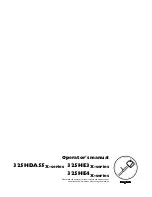
EN
30
∫
If possible, fix the workpiece with clamps.
If you are holding the workpiece by hand,
always keep your hand at least 100 mm
from either side of the saw blade. Do not
use this saw to cut workpieces that are
too small to be clamped or held safely by
hand.
If your hand is too close to the saw
blade, there is an increased risk of injury
from contact with the saw blade.
∫
The workpiece must be held firmly in place
and either clamped or pressed against
the fence and he table. Do not push the
workpiece into the saw blade and never cut
“freehand”.
Loose or moving workpieces
could be thrown out at high speed and
cause injure.
∫
Never put your hand over the intended
cutting line, or in front of or behind the
saw blade.
Supporting the workpiece with
crossed hands, i.e. holding the workpiece to
the right of the saw blade with the left hand
or vice versa, is very dangerous.
∫
Do not reach behind the fence while the
saw blade is turning. Always maintain
a safety distance of at least 100 mm
between your hand and the rotating saw
blade (this applies to both sides of the saw
blade, e.g. when removing wood debris).
The proximity of the rotating saw blade
to your hand is not always immediately
apparent and you could be seriously injured.
∫
Check the workpiece before starting the
cut. If the workpiece is bent or warped,
clamp it with the outwardly curved side
towards the fence. Always make sure that
there is no gap between the workpiece,
fence and table along the cutting line.
Bent
or warped workpieces can twist or shift and
cause the rotating saw blade to jam while
cutting. Make sure that there are no nails or
foreign bodies in the workpiece.
∫
Do not use the saw until the table is free of
tools, wood debris, etc; only the workpiece
should be on the table.
Small waste items,
loose pieces of wood or other objects that
come into contact with the rotating blade
can be thrown out at high speed.
∫
Only cut one workpiece at once.
Stacked
workpieces cannot be properly clamped or
held in place and can cause the blade to
jam or slip during sawing.
∫
Ensure that the mitre crosscut saw is
placed on a flat, solid work surface before
use.
A level and solid work surface reduces
the risk of the mitre crosscut saw becoming
unstable.
∫
Plan your work. Whenever you adjust the
saw blade bevel or mitre angel, make
sure that the adjustable fence is correctly
set and supports the workpiece without
coming into contact with the blade or the
blade guard.
Without switching on the machine and
with no workpiece on the table, simulate a
complete cutting movement using the saw
blade to ensure that there is no obstruction
or danger of cutting into the fence.
∫
With workpieces that are wider or longer
than the top of the table provide adequate
support, e.g. using table extensions or
a sawhorse.
Workpieces that are longer
or wider than the table of the mitre
crosscut saw could tilt if they are not firmly
supported. If a cut piece of wood or the
workpiece tips, it can lift the lower blade
guard or be thrown out uncontrollably by
the rotating blade.
∫
Do not use other people instead of a table
extension or for additional support.
If the
workpiece is not stably supported, the blade
can jam.
Also, the workpiece can shift during the cut
and pull you and the helper into the rotating
blade.
∫
The cut-off piece must not be pressed
against the rotating saw blade.
If there
is not much space, e.g. when using
longitudinal stops, the cut-off piece can
wedge into the blade and be thrown out
violently.
∫
Always use a clamp or a suitable device to
properly support round material such as
rods or pipes.
Bars tend to roll away during
cutting, causing the blade to “bite” and the
workpiece to be pulled into the blade along
with your hand.
Содержание 166892.01
Страница 77: ...cod articolo 166892 01 ...
















































